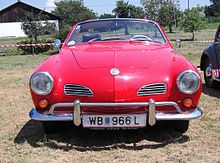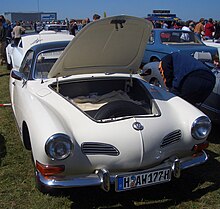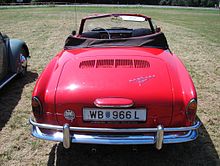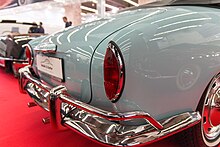VW Karmann Ghia Type 14
| VW | |
|---|---|
|
VW Karmann Ghia Type 14
|
|
| Karmann Ghia type 14 | |
| Production period: | 1955-1974 |
| Class : | Lower middle class |
| Body versions : | Coupé , convertible |
| Engines: |
Petrol engines : 1.2–1.6 liters (22–37 kW) |
| Length: | 4140-4280 mm |
| Width: | 1634 mm |
| Height: | 1330 mm |
| Wheelbase : | 2400 mm |
| Empty weight : | 820-940 kg |
| successor | VW Scirocco I. |
The VW Karmann-Ghia (Type 14) ([ 'gia ], not [ ' dʒia ]) is the name of an automobile from the Volkswagen factory that was built by Karmann in Osnabrück . A total of 443,466 cars (362,585 coupes and 80,881 convertibles) was Volkswagen settle 1955-1974. The engine and chassis of the Karmann Ghia Type 14 are largely the same as those of the VW Beetle , the base plate of the frame is slightly wider. The sports car was presented on July 14, 1955 as a coupé in gazelle beige.
The Type 14 (internal type numbers 141 to 144 for the various versions Coupé / Cabriolet, right / left-hand drive) is often referred to as the "little" Karmann-Ghia - VW had a Coupé of the same name in its range from 1961 to 1969 with the Type 34 which was based on the larger Type 3 (VW 1500/1600). There was also the type TC (for Touring Coupé, type 145), which was only built at the Karmann plant in São Bernardo do Campo (Brazil).
Model history
General
The body line of the Karmann-Ghia has several fathers, the proportions of which can no longer be clearly delineated today: the Italian Luigi Segre, employee of Carrozzeria Ghia in Turin, was considered the designer of the Karmann-Ghia. Segre was a mechanical engineer and worked for Ghia as a contact for Karmann. The prototype of the Type 14 was designed by Felice Mario Boano and his son Gian Paolo in the Turin body shop . Their work was based on a prototype previously built by Ghia for Chrysler in the USA. Its design in turn comes from the head designer of the US company, Virgil Exner .
Series production began in 1955. The car was a success - over 30,000 vehicles were produced annually from 1964 to 1970. VW sold 61 percent (271,736 vehicles) in the USA, even if the “little” Karmann Ghia was often referred to as a “housewife Porsche” and a “secretary Ferrari” in Germany: the car looks like a sports car, but it was with an initial 30 PS (22 kW) and a top speed of 118 km / h, far from sporting records.
From 1962 to 1972, the São Bernardo do Campo plant near São Paulo in Brazil produced almost 23,500 coupés and 176 convertibles of a modified Type 14 version with different bumpers and rear lights, and from 1970 with additional opening windows at the front. In this plant, 18,119 copies of the Karmann-Ghia TC (Type 145) were built only as coupé between 1970 and 1976.
Dashboard of a Karmann Ghia Type 14 convertible
Overview
- 1951 Wilhelm Karmann and Volkswagen General Director Heinrich Nordhoff speak for the first time about a Beetle-based sports coupé. Type 14 designs are created in Osnabrück. At this point in time, the front was still very similar to that of the Beetle, while the rear section already had its characteristic features.
- 1953 Luigi Segre produces the prototype in Turin. Wilhelm Karmann was spontaneously enthusiastic and presented the design to VW boss Nordhoff on November 16, 1953. Both decide on the same day to start series production.
- 1954 Karmann develops the prototype for series production, sets up an assembly line in Osnabrück and lays the logistical basis for series production.
- 1955 The VW Karmann-Ghia Coupé is presented to VW dealers and journalists. Shortly after the release ceremony on July 14th at the Casino Hotel Georgsmarienhütte , it can be seen that opinions about the car differ. The magazine Das Auto, Motor und Sport praises elegance and solidity on the one hand, but also considers the tested Type 14 to be the "parody of a fast car" (Issue 11, May 26, 1956, p. 4). The car, which the specialist audience will see on July 14th, is “gazelle beige” on the outside and brown leather on the inside. In the following month, series production of the Type 14 (in-house Type 143) based on the export Beetle begins . That of a 30 PS strong air-cooled four- cylinder - piston engine powered car costs 7,500 DM from Osnabrück.
- 1956 The ten thousandth Type 14 Coupé rolls off the assembly line. More than half of the production is exported. The experienced coachbuilder and designer Johannes Beeskow is responsible for technical development at Karmann .
- 1957 On the 38th IAA is the Karmann Ghia convertible presented. The vehicle produced in Osnabrück from November 1, 1957 costs 8,250 DM.
- 1958 Gas foot pedal instead of gas roller, defroster system on the rear window, improved seats.
-
1959 After the factory holidays , the Type 14 received its first facelift . The changes include
- larger headlights, which are now mounted approx. 5 cm higher,
- the front air inlets ( colloquially called nostrils) are enlarged and framed in chrome,
- the windows in the rear can be opened,
- the rear lights have separate housings for tail lights, stop lights and indicators,
- an armrest is installed on the inside of the driver's door,
- Windscreen washer and headlight flasher are standard
- 1960 Karmann opens its plant in São Bernardo do Campo. Production at Karmann-Ghia do Brasil begins on December 31, 1960. The Type 14 is now being equipped with a newly designed 34 hp engine, just like the export version of the VW Beetle.
- 1961 The "big" Karmann Ghia ( Type 34 ) goes into series production on September 1st. It will not be presented to the public until eight days later at the IAA . With the 45 hp (33 kW) engine, the 34 model reached 137 km / h. The cabriolet version that was also presented , however, never went into series production. It is available with an electric sunroof for an extra charge of DM 750 from the start. At DM 8,750, the price of the coupé was very high for the time and was later reduced by DM 450 (for comparison: the Type 14 with a 34 hp engine cost DM 6,935). Despite the price reduction, sales of the “big” Karmann Ghia remain sluggish.
- 1963 from August: The Type 34 becomes the 1500 S with 54 hp (40 kW). Only now does it have a top speed of 150 km / h and an acceleration from 0 to 100 km / h in 18 s. However, the engine is relatively sensitive and requires premium gasoline due to the higher compression.
- 1965 As of August, the Type 14, like the VW Beetle at the same time, receives a 40 hp engine with a capacity of 1300 cc. The Type 34 becomes the 1600 L with 54 hp again, and can now be driven on regular gasoline again. Now the big Karmann has disc brakes at the front. The 1600 L tends to have poorer performance (145 km / h, from 0-100 km / h in 19 s), but it is significantly less sensitive than the 1500 S.
- 1966 A new engine was available for the Type 14 after just one year, which now developed 44 hp (32 kW) from 1500 cm³, again in parallel with the most powerful Beetle model. There are changes to the chassis . Among other things, the front drum brakes are replaced by disc brakes .
- 1967 Both Karmann types 14 and 34 receive a further facelift. The tank opening is moved from the trunk to the fender and the vehicle electrics are switched to 12 volts . From September there will be the Type 14 with a semi-automatic mechanism (surcharge 465 DM), which brings with it a rear trailing arm axle that is safer to drive .
- 1968 The little Karmann now gets a hazard warning system as standard. The driver and front passenger seats move closer to each other, which leads to a better view of the passengers in front. Like the VW 1600, the large type is now also available with a fully automatic system. With the introduction of the fully automatic system, the big Karmann switched to semi-trailing arm rear axles, which the cars with manual transmissions also get. The rear axle of the "little Karmann" with a manual transmission remains the old swing axle until mid-1970 .
- 1969 In June 1969, production of the Type 34 ceased after (only) 42,505 units. Type 14 has angular indicators at the front . In the convertible version, the rear window is now made of glass instead of plastic.
- 1970 The version of the Type 14 built in Brazil has additional opening side windows at the front. In addition, production of the TC type will start in Brazil in August. The chassis of the type TC comes again from Volkswagen , this time not from the VW Beetle , but from a type 3 . From 1970 onwards, the Karmann, whether made in Germany or Brazil, will roll on the streets with the same 50 hp (34 kW) engine with 1,600 cm³ that the new Beetle 1302 S has. The "little" Karmann does not receive its new strut front axle; it cannot be integrated into the Karmann front. Now, however, all new Karmann Ghia have the safe semi-trailing arm axle.
- 1972 The Brazilian version of the Type 14 is discontinued. The Karmann Ghia built in Germany get another facelift with large taillights.
- 1972 Last external changes, "large" bumpers and slight changes to the body. Large front indicators.
- 1974 The successor VW Scirocco comes onto the market in spring and German production of the Karmann Ghia ends on July 31st.
- 1976 The production of the Coupé type TC is stopped in Brazil. The model was built there around 18,000 times. The head of technical development, Johannes Beeskow , is retiring.
Production numbers
Production figures according to company information:
- Type 14 Coupé 385.803
- Type 14 Cabriolet 81.053
- Type 34 Coupé 42.505
- Type TC 18.119
Technical specifications
| Technical data VW Karmann-Ghia 1955–1974 | |||||||||||
| VW Karmann Ghia: | 1192/30 hp (1955/60) | 1192/34 hp (1960/65) | 1285/40 hp (1965/66) | 1493/44 hp (1966/70) | 1584/50 hp (1970/74) | Type 34/1500 (1962/63) | Type 34/1500 S (1963/65) | Type 34/1600 L (1965/69) | Karmann-Ghia TC (Brazil) | ||
|---|---|---|---|---|---|---|---|---|---|---|---|
| Engine: | 4-cylinder boxer engine (four-stroke) | ||||||||||
| Displacement: | 1192 cc | 1285 cc | 1493 cc | 1584 cc | 1493 cc | 1584 cc | |||||
| Bore × stroke: | 77 × 64 mm | 77 × 69 mm | 83 × 69 mm | 85.5 × 69 mm | 83 × 69 mm | 85.5 × 69 mm | |||||
| Performance at 1 / min: | 22 kW (30 hp) at 3400 |
25 kW (34 PS) at 3600 |
29 kW (40 hp) at 4000 |
32 kW (44 hp) at 4000 |
37 kW (50 PS) at 4000 |
33 kW (45 PS) at 3800 |
40 kW (54 hp) at 4200 |
40 kW (54 hp) at 4000 |
40 kW (54 hp) at 4200 |
||
| Max. Torque at 1 / min: | 75 Nm at 2000 | 82 Nm at 2000 | 87 Nm at 2000 | 100 Nm at 2000 | 106 Nm at 2800 | 106 Nm at 2000 | 106 Nm at 2400 | 110 Nm at 2200 | 112 Nm at 2600 | ||
| Mixture preparation: | 1 downdraft carburetor Solex 28 | 1 downdraft carburetor Solex 30 | 1 downdraft carburetor Solex 34 | 1 flat-flow carburetor Solex 32 | 1 downdraft carburetor Solex 32 | 2 downdraft carburetors Solex 32 (aW from June 1968 electronic Bosch injection) | 1 downdraft carburetor Solex 32 | ||||
| Valve control: | Bumpers and rocker arms, central camshaft, spur gears | ||||||||||
| Cooling: | Air cooling | ||||||||||
| Transmission: | 4-speed gearbox, middle shift (40 HP 1965/66 aW with Saxomat (then 34 HP); 44 and 50 HP from 1968 aW with three-speed semi-automatic) |
4-speed gearbox, center shift | |||||||||
| Front suspension: | Crank arm axle , 2 transverse spring bars | ||||||||||
| Rear suspension: | Pendulum axle, trailing arm , transverse spring bars (automatic models from 1968 and type 34/1600 L from 08/68: semi-trailing arm axle ("double joint axle"), transverse spring bars) |
||||||||||
| Brakes: | Drum brakes all around, hydraulically operated (Ø 230 mm) | Front disc brakes (Ø 277 mm), rear drums (Ø 230 mm) | Drum brakes all around, hydraulically operated (Ø 230 mm) | Drum brakes all around, hydraulically operated (Ø 248 mm) | Front disc brakes (Ø 278 mm), rear drums (Ø 230 mm) | ||||||
| Body: | Sheet steel on a central tube platform frame | ||||||||||
| Track width front / rear: | 1290-1305 / 1250-1350 mm | 1310/1346 mm | 1315/1360 mm | ||||||||
| Wheelbase: | 2400 mm | ||||||||||
| Length: | 4140 mm | 4280 mm | 4210 mm | ||||||||
| Empty weight: | 820-870 kg | 910-940 kg | 920 kg | ||||||||
| Top speed: | 118 km / h | 122 km / h | 128 km / h | 136 km / h Aut .: 130 km / h |
140 km / h Aut: 134 km / h |
137 km / h | 150 km / h | 150 km / h Aut .: 140 km / h |
142 km / h | ||
| 0-100 km / h: | 33 p | 31 p | 27 p | 23 s Aut .: 28 s |
21 s Aut .: 24 s |
22.5 s | 19 s | 19 s 25 s |
n / A | ||
| Consumption (liters / 100 kilometers): | 8.0 N | 8.5 N | 9.5 N | 10.0 N Aut .: 11.0 N |
11.5 N Aut .: 12.5 N |
10.0 N | 10.5 N Aut .: 11.5 N |
11.5 N Aut .: 12.5 N |
9.1 N | ||
| Price (DM): | Coupé: 7,500 (08/55) Cabriolet: 8,250 (08/55) |
Coupé: 6,935 (04/62) Cabriolet: 7,635 (04/62) |
Coupé: 6,990 (08/65) Cabriolet: 7,690 (08/65) |
Coupé: 7,445 (08/66) Cabriolet: 7,995 (08/66) |
Coupé: 7,990 (08/70) Cabriolet: 8,790 (08/70) |
8,750 (08/61) | 8,900 (08/63) | 8,750 (08/65) | - | ||
Karmann-Ghia today
With "Karmann-Ghia" is usually meant the type 14 today, while the type 34 is referred to as the "big Karmann". The type TC was not offered in Europe and is largely unknown here.
Like many other vehicles from the 1950s and 1960s, the Karmann Ghia has a considerable following. The drivers are often organized in interest groups or clubs and share their hobby at meetings and trips.
The supply of spare parts is usually very good, even if not always inexpensive. Body panels for the Type 14 are hard to come by, especially the bumpers and complete (welded) front sections. The Karmann Ghia is derived from the Beetle, but in some details, compared to the Beetle sedan and also the Beetle Cabrio , it is a significantly more complex vehicle.
The price for well-preserved vehicles is in the five-digit euro range for the sedan, the open version is valued higher (as of May 2014).
Replica
Body replicas have been enjoying growing popularity for some time. Since the early 1990s, companies have been offering replicas of the Karmann Ghia based on a (previously approved) Beetle chassis on which a fiberglass body is placed. One advantage of such new builds is the use of modern materials and engines. The H license plate and the correspondingly cheap car insurance are denied replicas .
Film appearances
A Karmann-Ghia Coupé Type 14 from the first series can often be seen in the comedy film Immer die Radfahrer from 1958.
Robert Redford drove an orange model in sneakers - The silent ones , the one in Mike Myer's darling a year later , will you hold the ax? appears again.
In the thriller Vertigo by Alfred Hitchcock , the Hollywood star was driving Kim Novak , a steel blue Karmann Ghia coupe.
In the Tarantino film Kill Bill - Volume 2 , the bride ( Uma Thurman ) drives a Karmann Ghia Type 14.
In the film Maria, he doesn't like it! from 2009 the car is the main character's car Jan.
In John Carpenter's film Halloween - The Night of Horror , two VW classics can be seen parked one behind the other on the roadside in one shot: a Beetle and a Karmann-Ghia Coupé Type 14.
In the ZDF television series Der Bastian , the main actor's girlfriend drives a Karmann Ghia.
The music video for the song “Intoxication” by Gentleman shows a Karmann convertible and for the song “Souvenir” by Orchestral Maneuvers in the Dark , the singer drives a right-hand drive convertible.
Brad Pitt drives a shabby Karmann convertible in his role as stunt double Cliff Booth in Quentin Tarantino's 2019 film Once Upon a Time in Hollywood .
literature
- Reinhard Lintelmann: Karmann Ghia . Komet, Cologne 2009, ISBN 978-3-89836-864-3 .
- Halwart Schrader: Karmann Ghia - Coupes and Cabriolets 1955–1974 . Schrader-Motor-Chronik 1990, ISBN 3-922617-62-X .
- Ulrich Brinkhoff: Nightmares on the Saigon River, South Vietnam 1965–1968. agenda Verlag, Münster 2014, ISBN 978-3-89688-516-6 , 243 pages with 120 illustrations. (with foreword by Walter Scheel)
Web links
- 50 years of Karmann-Ghia , Volkswagen AutoMuseum
- Karmann
- Link catalog on the topic of Karmann-Ghia at curlie.org (formerly DMOZ )
- 50 years of Karmann Ghia
- Archive with color tables, literature and technical data on the car
Individual evidence
- ↑ automuseum.volkswagen.de ( Memento from April 10, 2010 in the Internet Archive )
- ↑ Christof Gaißmayer: July 14th, 1955: VW presents the "Karmann Ghia". SWR2, July 14, 2017, accessed on July 14, 2017 .
- ↑ Claudia Böhler: Scirocco. Excitingly sensible. The Volkswagen Scirocco 1974 - 1992 , p. 8, model stories, series of historical communications by Volkswagen Aktiengesellschaft (2008), ISBN 978-3-935112-33-8
- ↑ Karmann Ghia "Model 1958" . In: Motor vehicle technology 8/1958, p. 303.
- ↑ Jürgen Pander: The Karmann Ghia sports coupé started its career 50 years ago and conquered the world from Osnabrück to Hollywood. Berliner Zeitung, August 6, 2005, accessed on July 14, 2017 .
- ↑ Trivia for Kill Bill: Vol. 2 from the Internet Movie Database IMDb
- ↑ Leading role for VW Karmann Ghia and Mercedes 190 ( Memento from August 1, 2013 in the Internet Archive ), report on motor-klassik.de
- ↑ IMCDb .org: "Once Upon a Time in Hollywood, 2019": cars, bikes, trucks and other vehicles. Retrieved August 18, 2019 .















